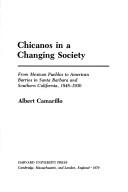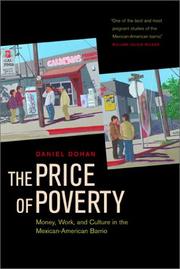| Listing 1 - 7 of 7 |
Sort by
|
Book
ISBN: 0814724701 9780814724705 9780814724835 0814724833 9780814784044 0814784046 9780814784051 0814784054 Year: 2012 Publisher: New York, NY
Abstract | Keywords | Export | Availability | Bookmark
 Loading...
Loading...Choose an application
- Reference Manager
- EndNote
- RefWorks (Direct export to RefWorks)
The nation’s Latina/o population has now reached over 50 million, or 15% of the estimated total U.S. population of 300 million, and a growing portion of the world’s population now lives and works in cities that are increasingly diverse. Latino Urbanism provides the first national perspective on Latina/o urban policy, addressing a wide range of planning policy issues that impact both Latinas/os in the US, as well as the nation as a whole, tracing how cities develop, function, and are affected by socio-economic change. The contributors are a diverse group of Latina/o scholars attempting to link their own unique theoretical interpretations and approaches to political and policy interventions in the spaces and cultures of everyday life. The three sections of the book address the politics of planning and its historic relationship with Latinas/os, the relationship between the Latina/o community and conventional urban planning issue sand challenges, and the future of urban policy and Latina/o barrios. Moving beyond a traditional analysis of Latinas/os in the Southwest, the volume expands the understanding of the important relationships between urbanization and Latinas/os including Mexican Americans of several generations within the context of the restructuring of cities, in view of the cultural and political transformation currently encompassing the nation.
Hispanic American neighborhoods. --- City planning --- Hispanic Americans --- Barrios (United States) --- Neighborhoods, Hispanic American --- Ethnic neighborhoods --- Social conditions.
Book
ISBN: 0814768563 0814768008 9780814768006 9780814768563 9780814791288 081479128X 9780814791295 0814791298 Year: 2010 Publisher: New York, NY
Abstract | Keywords | Export | Availability | Bookmark
 Loading...
Loading...Choose an application
- Reference Manager
- EndNote
- RefWorks (Direct export to RefWorks)
Freighted with meaning, “el barrio” is both place and metaphor for Latino populations in the United States. Though it has symbolized both marginalization and robust and empowered communities, the construct of el barrio has often reproduced static understandings of Latino life; they fail to account for recent demographic shifts in urban centers such as New York, Chicago, Miami, and Los Angeles, and in areas outside of these historic communities.Beyond El Barrio features new scholarship that critically interrogates how Latinos are portrayed in media, public policy and popular culture, as well as the material conditions in which different Latina/o groups build meaningful communities both within and across national affiliations. Drawing from history, media studies, cultural studies, and anthropology, the contributors illustrate how despite the hypervisibility of Latinos and Latin American immigrants in recent political debates and popular culture, the daily lives of America’s new “majority minority” remain largely invisible and mischaracterized.Taken together, these essays provide analyses that not only defy stubborn stereotypes, but also present novel narratives of Latina/o communities that do not fit within recognizable categories. In this way, this book helps us to move “beyond el barrio”: beyond stereotype and stigmatizing tropes, as well as nostalgic and uncritical portraits of complex and heterogeneous range of Latina/o lives.
Book
ISBN: 0822982382 9780822982388 0822964392 9780822964391 Year: 2017 Publisher: Pittsburgh, Pa.
Abstract | Keywords | Export | Availability | Bookmark
 Loading...
Loading...Choose an application
- Reference Manager
- EndNote
- RefWorks (Direct export to RefWorks)
"Mexican-American life, like that of nearly every contemporary community, has been extensively photographed. Yet there is surprisingly little scholarship on Chicano photography. Picturing the Barrio presents the first book-length examination on the topic. David William Foster analyzes the imagery of ten distinctive artists who offer a range of approaches to portraying Chicano life. The production of each artist is examined as an ideological interpretation of how Chicano experience is constructed and interpreted through the medium of photography, in sites ranging from the traditional barrio to large metropolitan societies. These photographers present artistic as well as documentary images of the socially invisible. They and their subjects grapple with definitions of identity, as well as ethnicity and gender. As such, this study deepens our understanding of the many interpretations of the Chicano experience"--Provided by publisher.
Mexican Americans --- Community life --- Mexican American neighborhoods --- Chicanos --- Hispanos --- Ethnology --- Barrios (United States) --- Ethnic neighborhoods --- Associations, institutions, etc. --- Human ecology --- Social life and customs --- Ethnic identity --- Social conditions

ISBN: 0674113950 Year: 1979 Publisher: Cambridge, Mass. ; London Harvard University Press
Abstract | Keywords | Export | Availability | Bookmark
 Loading...
Loading...Choose an application
- Reference Manager
- EndNote
- RefWorks (Direct export to RefWorks)
#SBIB:39A74 --- #SBIB:39A11 --- Hispanic American neighborhoods --- -Hispanic American neighborhoods --- -Mexican Americans --- -Chicanos --- Hispanos --- Mexican Americans --- Ethnology --- Barrios (United States) --- Neighborhoods, Hispanic American --- Ethnic neighborhoods --- Etnografie: Amerika --- Antropologie : socio-politieke structuren en relaties --- History --- California, Southern --- -Santa Barbara (Calif.) --- -Southern California --- -Etnografie: Amerika --- -History --- Chicanos --- Santa Barbara (Calif.) --- Southern California --- History. --- California --- Santa Barbara, Calif. --- California [Southern ] --- City of Santa Barbara (Calif.)

ISBN: 9786610281961 1135943206 1280281960 0203020960 9780203020968 9780415945417 0415945410 9780415945424 0415945429 6610281963 0415945410 0415945429 9781135943158 9781135943196 9781135943202 1135943192 9781280281969 Year: 2005 Publisher: New York : Routledge,
Abstract | Keywords | Export | Availability | Bookmark
 Loading...
Loading...Choose an application
- Reference Manager
- EndNote
- RefWorks (Direct export to RefWorks)
Taking into account the author's consideration of this subject from a planning and urban policy perspective, this book charts the history of the largest ethnic population in America.
Mexican Americans --- Urban policy --- City planning --- Land use, Urban --- Hispanic American neighborhoods --- Barrios (United States) --- Neighborhoods, Hispanic American --- Ethnic neighborhoods --- Urban land use --- Cities and towns --- Urban economics --- Urban renewal --- Cities and state --- Urban problems --- City and town life --- Economic policy --- Social policy --- Sociology, Urban --- History. --- Mexican Americans history --- history
Book
ISBN: 3319737147 3319737155 Year: 2018 Publisher: Cham : Springer International Publishing : Imprint: Palgrave Macmillan,
Abstract | Keywords | Export | Availability | Bookmark
 Loading...
Loading...Choose an application
- Reference Manager
- EndNote
- RefWorks (Direct export to RefWorks)
Focusing on shopkeepers in Latino/a neighborhoods in Los Angeles, Dolores Trevizo and Mary Lopez reveal how neighborhood poverty affects the business performance of Mexican immigrant entrepreneurs. Their survey of shopkeepers in twenty immigrant neighborhoods demonstrates that even slightly less impoverished, multiethnic communities offer better business opportunities than do the highly impoverished, racially segregated Mexican neighborhoods of Los Angeles. Their findings reveal previously overlooked aspects of microclass, as well as “legal capital” advantages. The authors argue that even poor Mexican immigrants whose class backgrounds in Mexico imparted an entrepreneurial disposition can achieve a modicum of business success in the right (U.S.) neighborhood context, and the more quickly they build legal capital, the better their outcomes. While the authors show that the local place characteristics of neighborhoods both reflect and reproduce class and racial inequalities, they also demonstrate that the diversity of experience among Mexican immigrants living within the spatial boundaries of these communities can contribute to economic mobility.
Neighborhoods --- Hispanic American neighborhoods --- Barrios (United States) --- Neighborhoods, Hispanic American --- Ethnic neighborhoods --- Neighborhood --- Neighbourhoods --- Communities --- Economic aspects --- Racism in the social sciences. --- Ethnicity. --- Ethnology-Latin America. --- Social Structure, Social Inequality. --- Sociology of Racism. --- Ethnicity Studies. --- Latin American Culture. --- Ethnic identity --- Group identity --- Cultural fusion --- Multiculturalism --- Cultural pluralism --- Social sciences --- Social structure. --- Social inequality. --- Ethnology—Latin America. --- Egalitarianism --- Inequality --- Social equality --- Social inequality --- Political science --- Sociology --- Democracy --- Liberty --- Organization, Social --- Social organization --- Anthropology --- Social institutions --- Equality.

ISBN: 1282359738 0520937279 1597348317 9786612359736 9780520937277 1417520418 9781417520411 9781597348317 0520227565 9780520227569 0520238893 9780520238893 9781282359734 Year: 2003 Publisher: Berkeley, Calif. University of California Press
Abstract | Keywords | Export | Availability | Bookmark
 Loading...
Loading...Choose an application
- Reference Manager
- EndNote
- RefWorks (Direct export to RefWorks)
Drawing on two years of ethnographic fieldwork in two impoverished California communities-one made up of recent immigrants from Mexico, the other of U.S.-born Chicano citizens-this book provides an invaluable comparative perspective on Latino poverty in contemporary America. In northern California's high-tech Silicon Valley, author Daniel Dohan shows how recent immigrants get by on low-wage babysitting and dish-cleaning jobs. In the housing projects of Los Angeles, he documents how families and communities of U.S.-born Mexican Americans manage the social and economic dislocations of persistent poverty. Taking readers into worlds where public assistance, street crime, competition for low-wage jobs, and family, pride, and cross-cultural experiences intermingle, The Price of Poverty offers vivid portraits of everyday life in these Mexican American communities while addressing urgent policy questions such as: What accounts for joblessness? How can we make sense of crime in poor communities? Does welfare hurt or help?
Hispanic American neighborhoods --- Poor --- Mexican Americans --- Chicanos --- Hispanos --- Ethnology --- Barrios (United States) --- Neighborhoods, Hispanic American --- Ethnic neighborhoods --- Disadvantaged, Economically --- Economically disadvantaged --- Impoverished people --- Low-income people --- Pauperism --- Poor, The --- Poor people --- Persons --- Social classes --- Poverty --- Economic conditions. --- Economic conditions --- East Los Angeles (Calif.) --- San Jose (Calif.) --- City of San José (Calif.) --- Ethnic relations. --- Urban poor --- City dwellers --- american citizens. --- barrios. --- california. --- chicano citizens. --- class differences. --- contemporary america. --- cross cultural experiences. --- ethnographers. --- ethnographic study. --- fieldwork. --- financial concerns. --- impoverished communities. --- latino poverty. --- latinos. --- los angeles. --- low wage jobs. --- mexican american communities. --- mexican american culture. --- mexican americans. --- mexican immigrants. --- modern history. --- money and culture. --- poverty. --- public assistance. --- recent immigrants. --- regional survey. --- silicon valley. --- work culture. --- working class. --- Sociology of culture --- Social problems --- Sociology of minorities --- Community organization --- Mexico --- United States --- United States of America
| Listing 1 - 7 of 7 |
Sort by
|

 Search
Search Feedback
Feedback About UniCat
About UniCat  Help
Help News
News